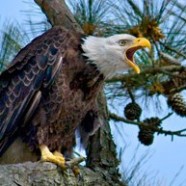
This project allowed Maryland state biologists to monitor the eagles post- release via satellite, and the resulting data revealed important information about the dispersal and habitat use of young eagles in the Chesapeake Bay. The tracking data was also be used as part of an innovative educational program in science and technology called Eye of the Falcon, which was being implemented in the Baltimore City School System.
Earthspan, a Baltimore non-profit organization, worked with representatives from the Maryland Department of Natural Resources (DNR) to track four of the five surviving eagles that were rescued from a muddy pit in Charles County, MD. The article below from the Washington Post describes the background of the situation. Earthspan donated one satellite transmitter (value = $3,050), and DNR agreed to support the tracking costs of this one unit for two years. Earthspan also provided three additional transmitters at its own expense in order to allow the other three juvenile eagles to be tracked upon their release back into the wild. Earthspan paid for the additional three transmitters and the tracking costs for each for two years.
The tracking data resulting from this effort was used in an Earthspan initiative called the Eye of the Falcon learning system. Eye of the Falcon is a science and technology curriculum that was currently being implemented in selected Baltimore City middle schools.
The Eye of the Falcon system was being supported by the Abell Foundation and the American Honda Foundation. The bald eagle tracking data will be used throughout the 2002-3 school year as Earthspan expanded the Eye of the Falcon system to more local schools.
By Monte Reel
Washington Post Staff Writer Sunday, May 12, 2002
Eight bald eagles became mired in a mining company’s silt pit near the Potomac River in Charles County last week, resulting in a multi- agency helicopter rescue and the possibility of federal charges against the company. Three of the birds died and five were treated at the Baltimore Zoo’s veterinary hospital after being found partially submerged in the muddy pit. The pit holds residue from the washing of sand and gravel at the Goose Bay facility operated by Maryland Rock Industries, Inc. near Nanjemoy.
The pit covers about seven acres and contains silt that is the consistency of mayonnaise, according to those involved in the rescue efforts. Officials with the U.S. Fish and Wildlife Service were investigating whether Maryland Rock could be charged with violating federal acts that protect bald eagles. According to the Bald and Golden Eagle Protection Act, anyone who “knowingly, or with wanton disregard,” captures a bald eagle can be fined up to $5,000 per offense. Officials with the U.S. Attorney’s Office in Baltimore declined to comment on the status of the investigation on Friday.
Biologists with the Maryland Department of Natural Resources said they are not certain how the birds — seven eaglets and one adult — became trapped in the pit. However, they speculate that the juvenile birds, which often require a running start to become airborne, mistook the surface of the pit for solid ground and got stuck as they tried to race across it. As they flapped in the mud, the biologists said, other birds might have misinterpreted the flurry of activity as a signal that prey was being captured.
After an employee with Maryland Rock alerted DNR that the eagles were stuck in the pit Monday evening, agency officials on Tuesday enlisted the help of the helicopter rescue unit of the National Park Service in Washington. Sgt. Ron Galey, a pilot with the park service, steadied the hovering helicopter just inches over the pit Tuesday afternoon while colleagues grabbed the birds from the muck. Galey said that had the helicopter’s skids come in contact with the surface of the pit, the helicopter would have likely become stuck, too. “It was not without risk,” Galey said of the rescue.
The surviving birds were taken to Baltimore Zoo, where they were rinsed of mud and were recuperating at week’s end. Zoo officials said they expected the five eagles to recover and be released into the wild in a couple of weeks. However, Bryan King, a biologist with the DNR, said they will not be released in Southern Maryland. “With those silt ponds down there, it just would not be wise,” King said.
Maryland Rock’s operations along the Potomac have drawn opposition from residents who contend that sand and gravel mining is harmful to the largely undeveloped riverside environment, home to several rare species of plants and animals. The company last year was denied a permit from Charles County to dig on another stretch of riverfront land south of Goose Bay called Douglas Point.
The state and federal governments ended up buying more than 1,200 acres of the 1,500-acre Douglas Point site as part of a land preservation program. Maryland Rock retained about 263 inland acres and has applied for a permit to mine that property, which the company says would not harm the environment. The citizens group that fought the company’s mining application last year has vowed to oppose Maryland Rock’s most recent application. The site will not include a silt pit, but Deanna Wheeler, a leader of the citizens group, said the eagle incident proves that mining operations in wildlife areas are ill-advised. “We knew those sediment ponds are very dangerous,” Wheeler said.
Maryland Rock has processed sand and gravel at the Goose Bay facility since 1997. The company’s permit to operate on the site expires this year, and Wheeler said her group might explore the possibility of fighting renewal of the permit. Parran Bean, Maryland Rock’s area manager, said that since Tuesday the company has stationed an employee with an air horn at the pit to keep eagles away. He said the company also was considering purchasing automated noise cannons that would be set off periodically.
“I feel like we’ve done everything we could,” Bean said. “We’re reacting accordingly and following the recommendations of DNR and Fish and Wildlife.” Bean said the silt pit is one of two that has been at the site since the company acquired Goose Bay in 1997. An eagle got stuck in the pit once before a couple of years ago, he said, and DNR officials were able to retrieve it.
© 2002 The Washington Post Company